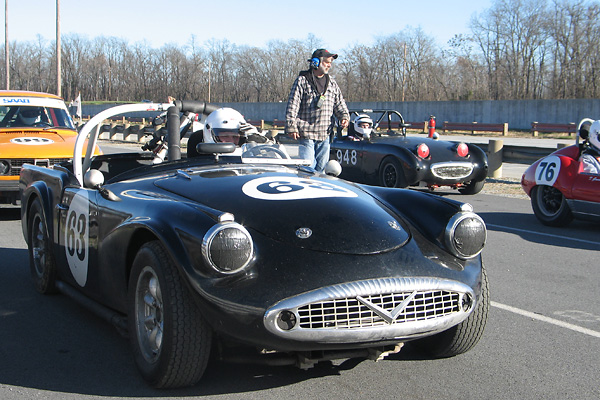
Joe Dockman's 1960 Daimler SP250 Race Car, Number 63
Owner: Joe Dockman
City: Baltimore MD
Model: 1960 Daimler SP250 (aka "Dart")
Engine: Daimler 2.5L V8
Restored and race prepared by: Robert Moser, and then Joe Dockman
Joe Dockman's Daimler SP250
Joe Dockman owns Daimler SP250 serial number 100185, which was originally purchased new
and raced (from 1960) by John Piggott. Its original color was Old English White.
Piggott raced the Daimler frequently at Marlboro Motor Raceway in Maryland. He usually
finished a strong and very respectable second place to another Daimler SP250; the
one famously driven by Duncan Black to an SCCA national championship victory.
In 1963 Piggott raced against an even more famous Daimler SP250 driver: Mark Donohue.
Richard McClure of Rockville Maryland purchased the SP250 from John Piggott sometime
in the mid-sixties. After completing SCCA drivers' school and then entering just one
race, McClure's employer transferred him to Hawaii. The Daimler went into storage for
a couple years, and ultimately was sold.
Robert Storck of Falls Church, Virginia bought SP250 number 100185 from Richard McClure
in 1969. His friend Robert Moser helped bring the car back into racing form, and
then crewed through three racing seasons. The car was repainted Dodge "Plum Crazy"
purple, and it raced as number 13.
The car's next owner was Jack Shafer of New Brunswick, New Jersey. He took it to a
professional race prep shop to be fixed up once again, but he never got to race it.
Robert Moser bought the SP250 in 1972. Painted silver and rechristened number 63,
the Daimler was enthusiastically raced by Robert Moser, who also did his own
maintenance and race preparation. After a major accident at Summit Point Motorsports
Park in 1974, Moser painted the Daimler black. He continued racing it through another
two seasons, before a limited family budget obliged him to stop. For sixteen years
the car wasn't raced. In about 1991, and the Moser family decided to dust off the
SP250 and get back into racing. Eventually though, Robert and his sons Joe and Bob
switched to a series of Acura and Honda racecars. (Most of them have also been
christened number "63".) They've continued to be very, very successful with the
Hondas in SCCA's Improved Touring classes over the last seventeen plus years.
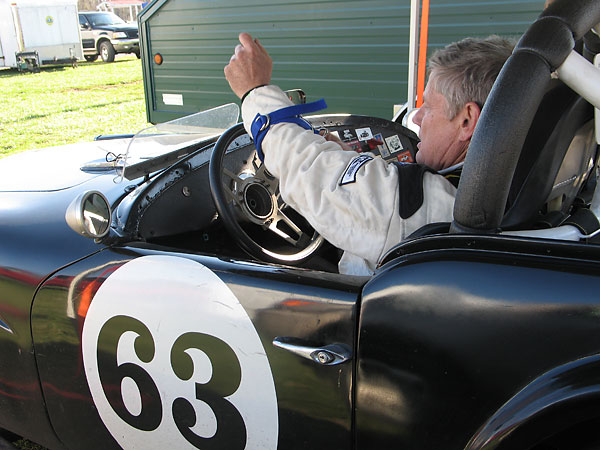
Joe Dockman prepares to race his Daimler SP250 at Summit Point Motorsports Park.
Joe Dockman used to be a frequent spectator at Marlboro Race Track back in the
mid 1960's. Watching those SCCA races, he fell in love with the sound of Duncan
Black's car. Joe couldn't afford the premium price of a Daimler back then, but
he didn't forget the sound and the fury of the SP250's. He stopped following the
SCCA racing scene when Marlboro closed in the early 1970's. Then, in the early
1990's Joe discovered a "barn fine" SP250 near his home in Maryland. It was a
former racecar from the 1960's that had previously been converted to street use.
It still had the old roll hoop. As he restored it, Joe thought about racing but
was concerned about the costs. Instead, he kept that SP250 as a street car, and
sometimes drove it to attend vintage races. The racing bug took hold of him,
and he began thinking about finding and building-up a second SP250 as a race car.
When he contacted Robert Moser for advice on building an SP250 race car, he found
Robert was extremely helpful. Then in one conversation Moser dropped the bomb. He
said that his car could be for sale since he was now racing Hondas with his son.
Joe Dockman purchased the number 63 Daimler from Robert Moser in February 2009.
The car still has Bob's imprint on it in many ways. The only really significant
change so far has been installation of the Kirkey aluminum racing seat. It fits
Joe better, and it's an important safety upgrade too. Joe explains: "Safety is
probably the most important thing to me, so that is what I will concentrate on."
One thing that will definitely stay is the car's color. Black is a surprisingly rare
color on vintage race cars, and Joe feels it suits his car perfectly. Then
there's the marvelous rumble of the Daimler V8 engine. That's something that makes
these cars very special.
Enjoying this article? www.BritishRaceCar.com is partially funded through generous support from readers like you!
To contribute to our operating budget, please click here and follow the instructions.
(Suggested contribution is twenty bucks per year. Feel free to give more!)
Notes about a couple rivals...
Duncan Black's SP250 was serial number 100033. The most successful of all SP250
racecars, Duncan Black's car was purchased, converted for street use, and then retained
within one family's ownership for over twentyfive years. Finally, in 2005, 100033 was
purchased by an British car dealer and shipped back to England. Its current owner is
John Abel, who purchased it in 2007. John has carefully and thoroughly documented 100033's
provenance, and has had the car restored to replicate how it appeared and performed
at the peak of Duncan Black's time with the car.
Another successful racing SP250 belonged to Bill Jarrell. It qualified for and raced
in the SCCA run-offs in 1973. Bill Jarrell's car was serial number 100163, and it raced
in the Washington DC region as car number 64. Bill is deceased, and ownership of
the SP250 has transferred to his son.
Features and Specifications
| Engine: | Daimler 2.5L Hemi, bored 0.040" over (2616cid).
Custom Venolia forged pistons on stock connecting rods.
Approximately 12:1 static compression ratio.
Custom ground camshaft.
Manley Performance valves.
Stock dual S.U. HD6 (1.75" bore) carburetors with special modified jet needles.
Stock Lucas distributor. Lucas sport coil.
Accel Hi-Temp SuperStock 8mm spark plug wires.
Pertronix digital rev limiter (set to 6000rpm).
Barnes Systems external single-stage (wet sump) oil pump.
An external oil line has been added to lubricate the cam and lifters more directly.
Accusump oil accumulator.
Mocal remote oil filter mount.
Fram HP1 racing filter. |
| Cooling: | original radiator, modified.
Spal electric cooling fan. |
| Exhaust: | custom 4-into-1 long primary headers flow into dual side pipes. |
| Transmission: | stock 4-speed.
Tilton 7.25" dual stage clutch.
Tilton flywheel. |
| Rear End: | Dana 44 (from a Sunbeam Tiger) with 3.92:1 gear ratio and Detroit Locker differential. |
| Front Susp.: | Triumph Competition coil springs with KONI adjustable shocks.
One inch sway bar. |
| Rear Susp.: | semi-elliptic leaf springs with a Panhard bar and Pro-Shocks tubular shocks. |
| Brakes: | (master) dual Tilton master cylinders with bias bar. Tilton brake balance valve on the rear circuit. (front) stock Girling disc brakes with 10" rotors and racing pads. (rear) stock Girling disc brakes with 10" rotors and racing pads. |
| Wheels/Tires: | genuine Minilite magnesium racing wheels with Hoosier Vintage TD (15" x 5.50") tires. |
| Electrical: | stock Lucas generator and starter.
Lead/acid battery. |
| Instruments: | (left to right)
original Smiths mechanical tachometer (0-7000rpm),
Stewart Warner coolant temperature gauge (100-260F),
Stewart Warner engine oil pressure gauge (5-100psi),
Stewart Warner oil temperature gauge (140-320F),
Lucas ammeter (+/-30 amps). |
| Fuel System: | Fuel Safe Systems 8 gallon fuel cell.
Facet fuel pump. |
| Safety Eqmt: | Kirkey aluminum racing seat.
Impact Racing five point latch-and-link safety harness.
Phoenix Fire Suppression System (5 pound Halon type, with bottle mounted in the boot.) |
| Weight: | at least 2040#, to comply with SVRA class requirements. |
| Racing Class: | due to changing rules this car has completed in SCCA's C, D, and E Production classes. |
Engine Installation
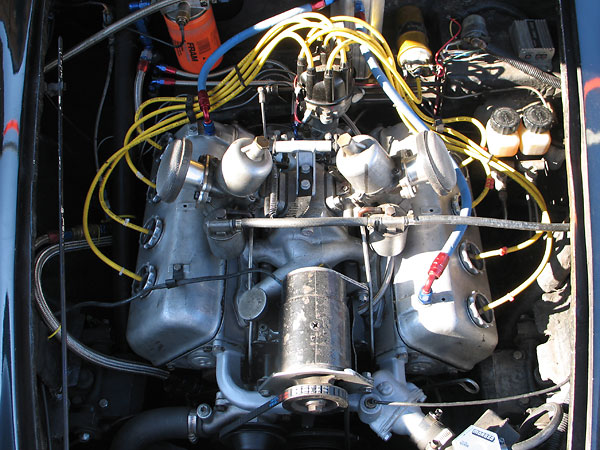
Ed Turner designed the Daimler engine. He was already famous for designing Triumph motorcycle engines.
The little hemi features an iron block topped with aluminum heads. Stock compression ratio was 8.2:1.
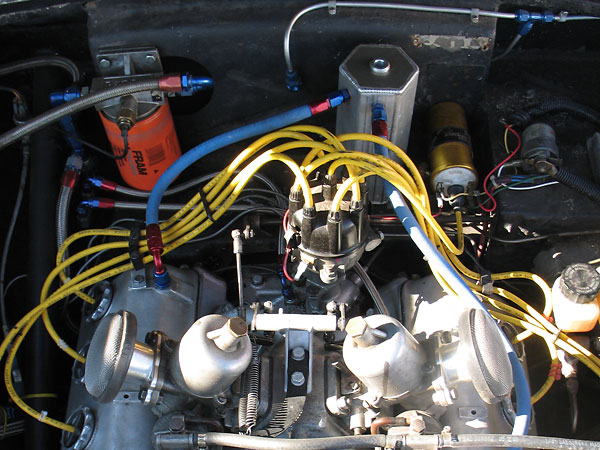
The 3.0" (76.2mm) bore by 2.75" (69.85mm) stroke yielded a 153 cubic inch (2548cc) displacement.
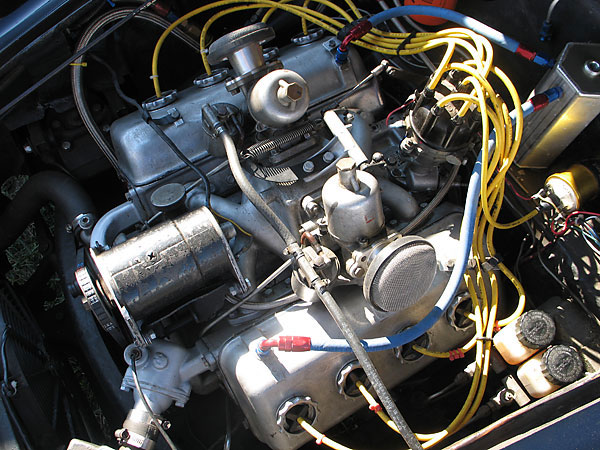
Notice the interesting coolant manifold and thermostat housing, underneath the Lucas generator.
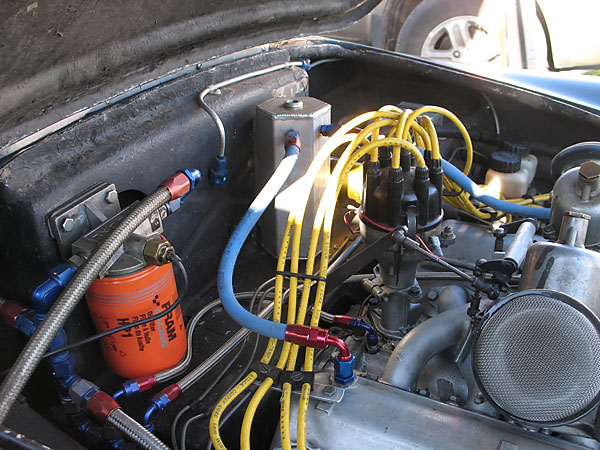
Mocal remote oil filter mount and Fram HP1 racing filter.
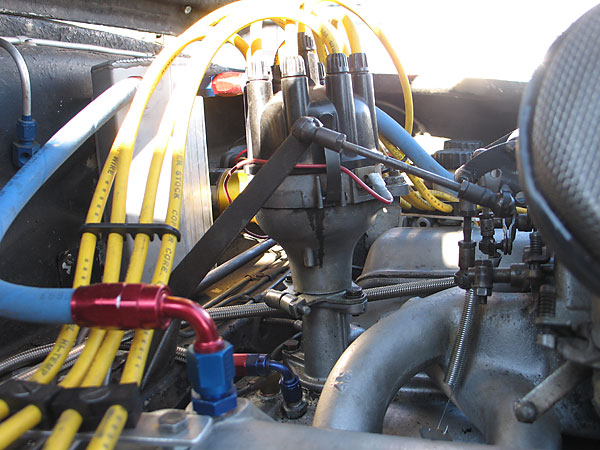
Stock Lucas distributor.
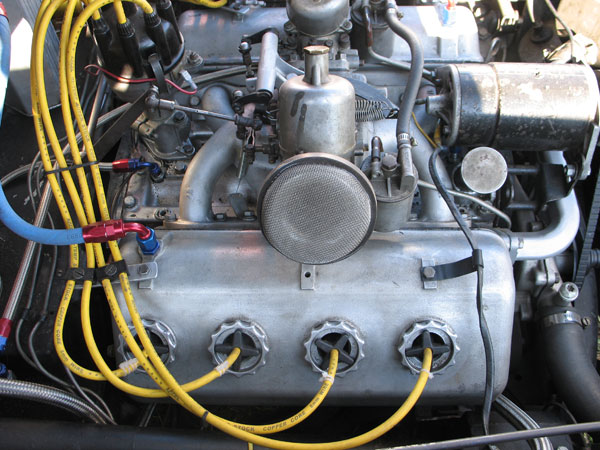
Stock dual HD6 (1.75" bore) S.U. carburetors with special modified jet needles.
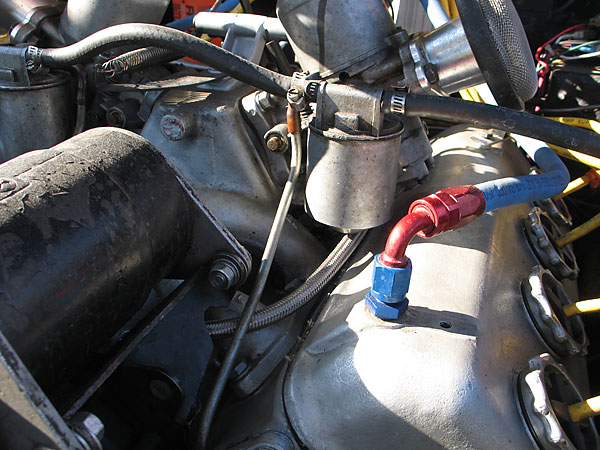
Notice the short and widely bell-mouthed velocity stacks.
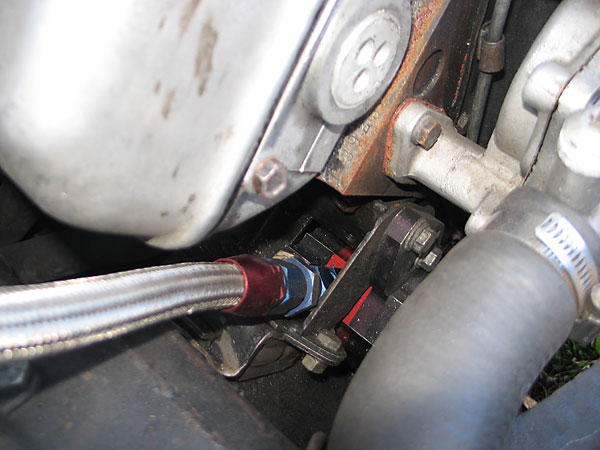
Barnes Systems external single-stage (wet sump) oil pump.

Dual Tilton brake master cylinders with bias bar. Girling clutch master cylinder.
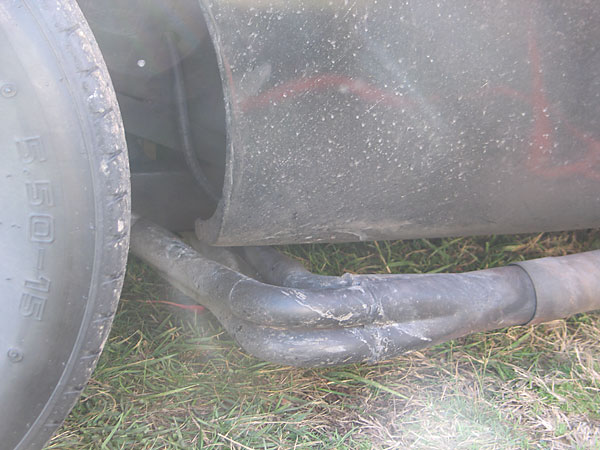
Custom 4-into-1 long primary headers flow into dual side pipes.
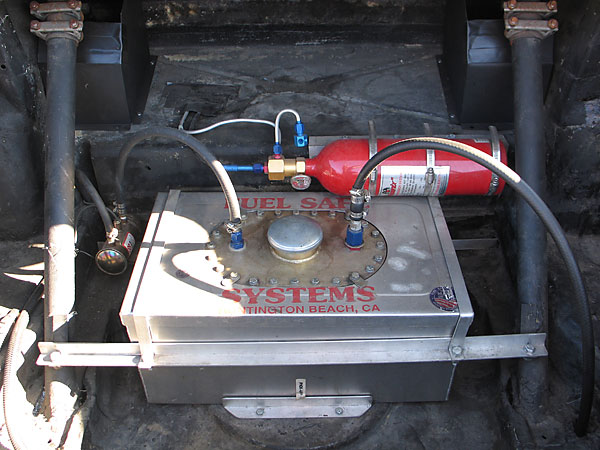
Fuel Safe Systems 8 gallon fuel cell. Facet fuel pump.
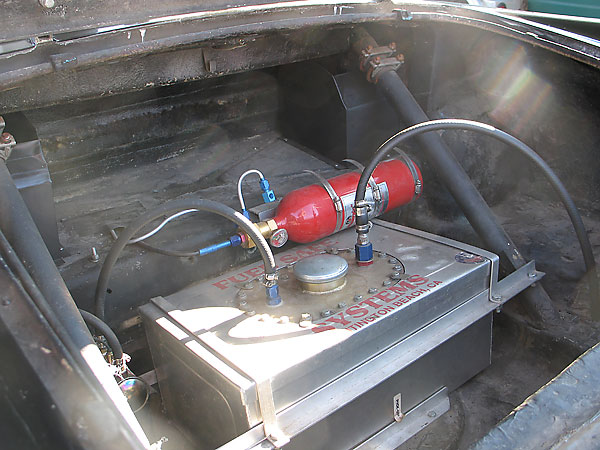
Phoenix Fire Suppression was a pioneer in offering Halon fire suppression systems for racing.
The company has now been sold to Stroud Safety, who offers a full line of safety equipment.
Front Suspension
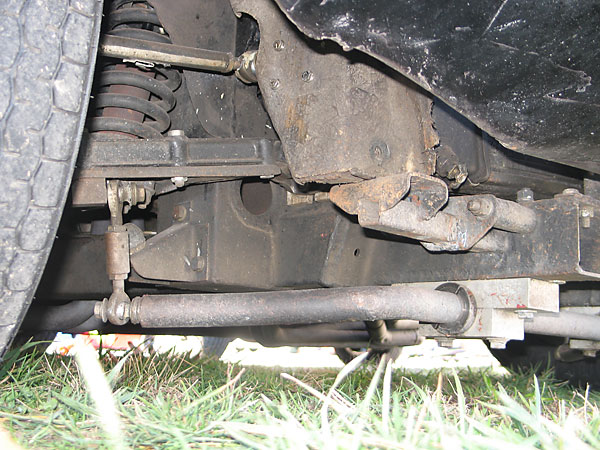
The frame front end was rebuilt with upgraded steel and crush tubes, and to support a 1 inch sway bar.
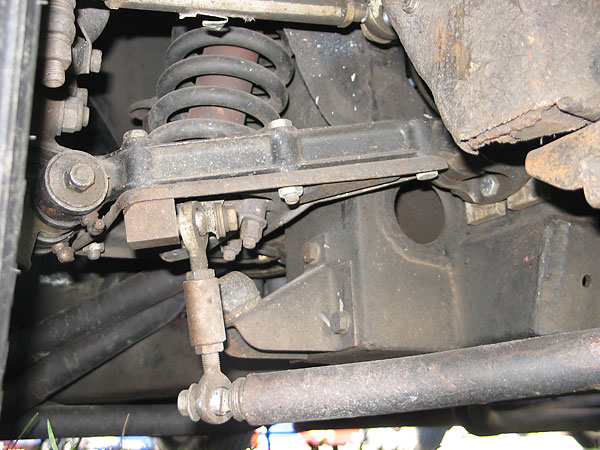
Triumph Competition coil springs with KONI adjustable shocks.
Interior
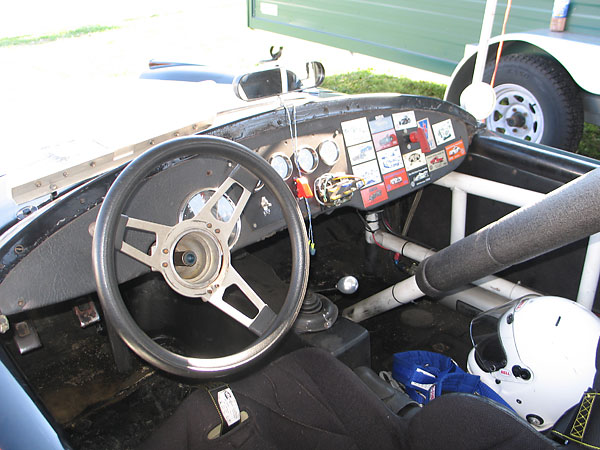
A "Petty bar" braces the main roll hoop, extending forward diagonally toward the passenger footwell.
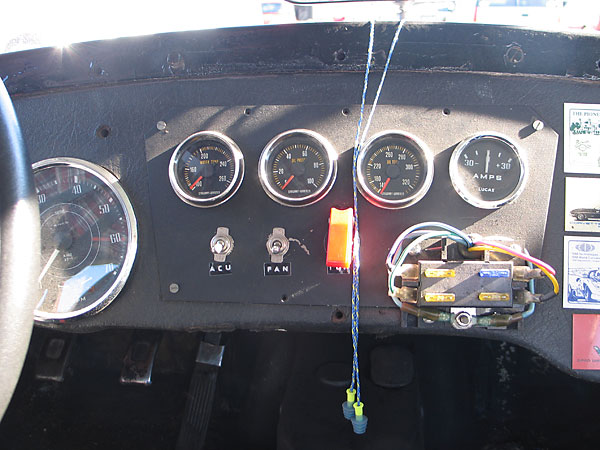
(left to right) Smiths mechanical tach (0-7000rpm), Stewart Warner coolant temperature gauge (100-260F),
engine oil pressure gauge (5-100psi), oil temperature gauge (140-320F), and Lucas ammeter (-30 to 30 amps).
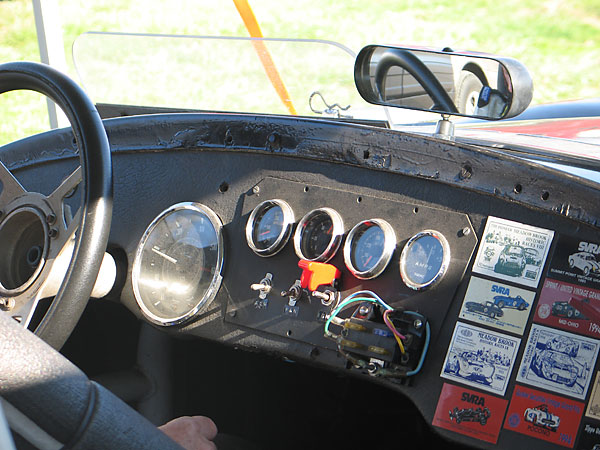
The three toggle switches are marked (left to right) "ACU", "FAN", and "IGN".
The ACU switch activitates a solenoid valve on the Accusump oil accumulator.
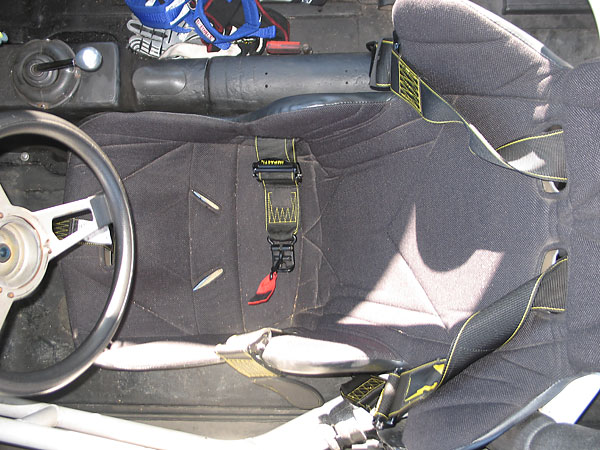
Kirkey aluminum racing seat, and Impact Racing five point latch-and-link safety harness.
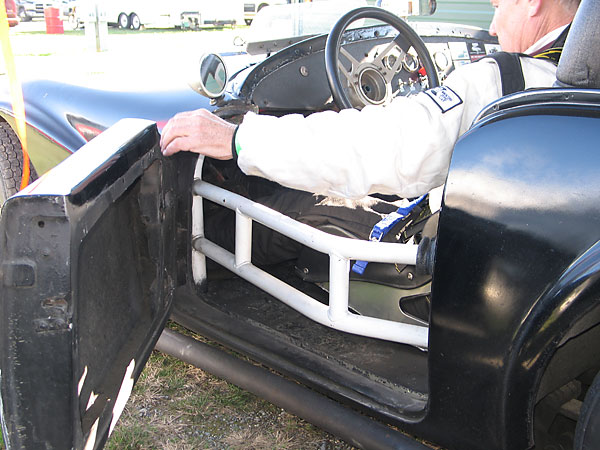
The roll cage features extra-strong protection from side intrusion.
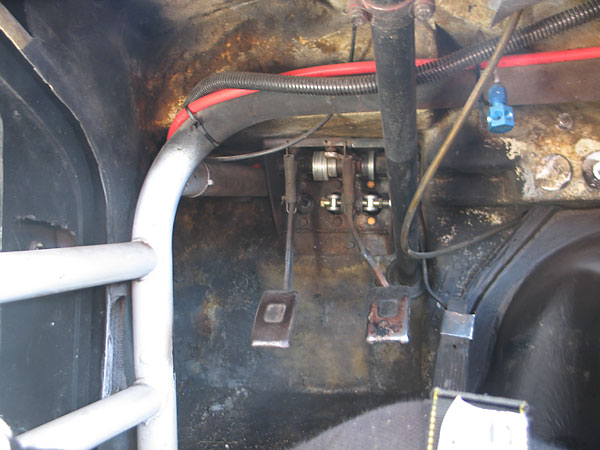
Note that the safety structure also extends forward through the firewall.
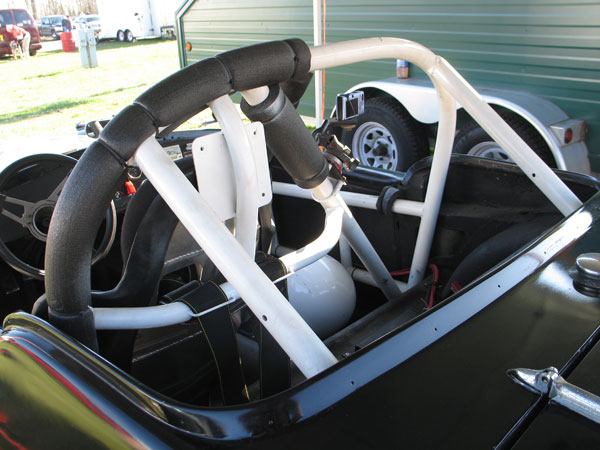
Quite large bend radii in the main roll hoop are a very nice - and very unusual - fabrication detail.
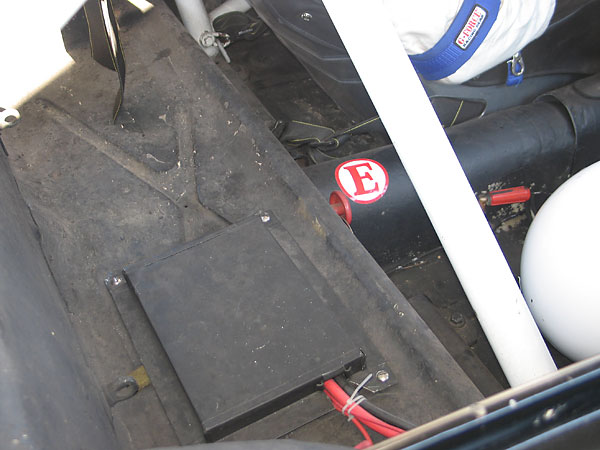
The battery is mounted under the rear shelf. Note also the Tilton brake balance valve on the driveshaft tunnel.
Exterior
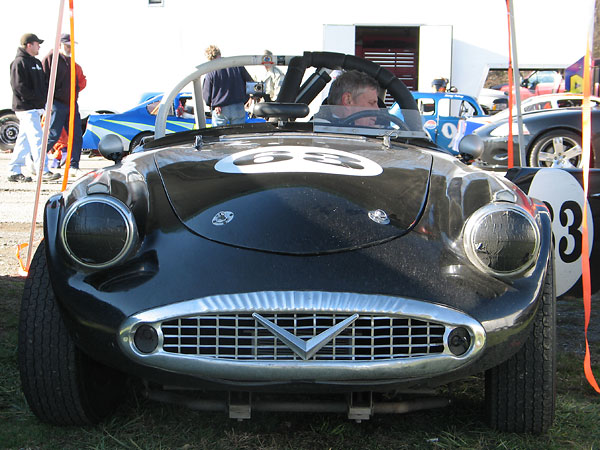
The crenulated top grille bar is a distinctive Daimler styling feature that dates back to 1923.
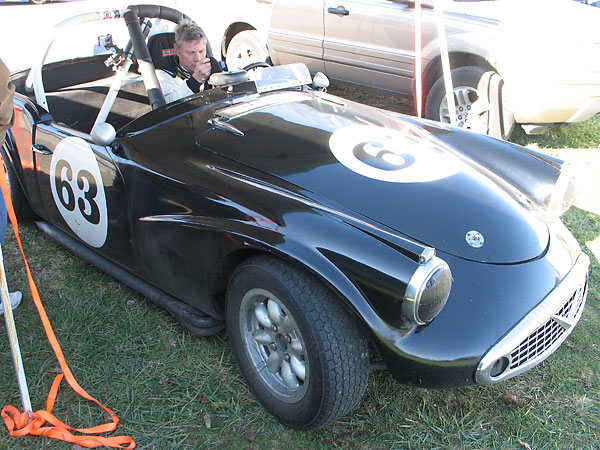
The Daimler SP250 was one of the first British street cars to come with an all-fiberglass body.
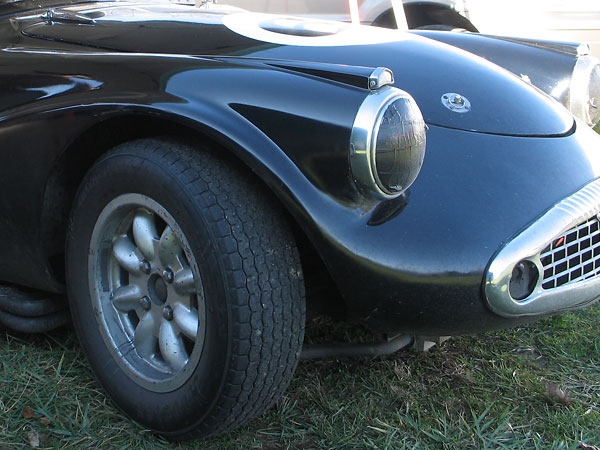
At the beginning of Daimler SP250 production, bumpers were considered "optional equipment".
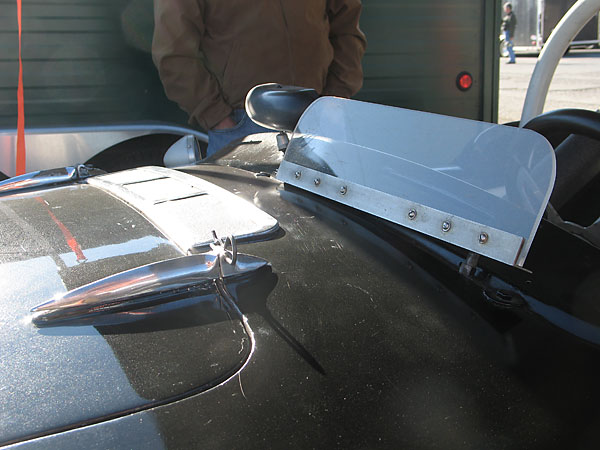
This compact perspex windscreen is a charming period modification.
Note also that special hingepins facilitate quick bonnet removal.
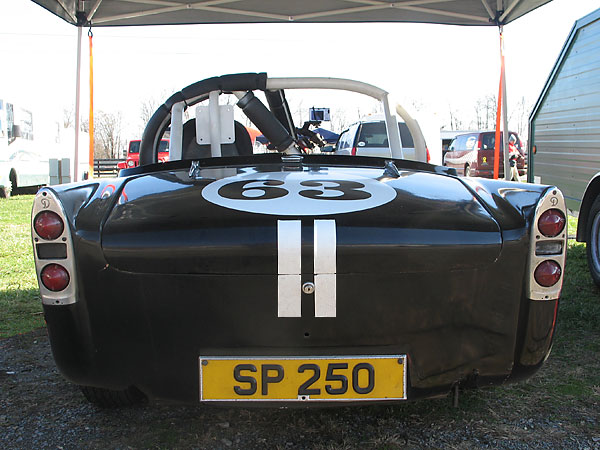
In the U.S. this model is called "SP250". Daimler was blocked from using the name "Dart" by Chrysler.
Mass production of the Dodge Dart started with Chrysler's 1960 model year.
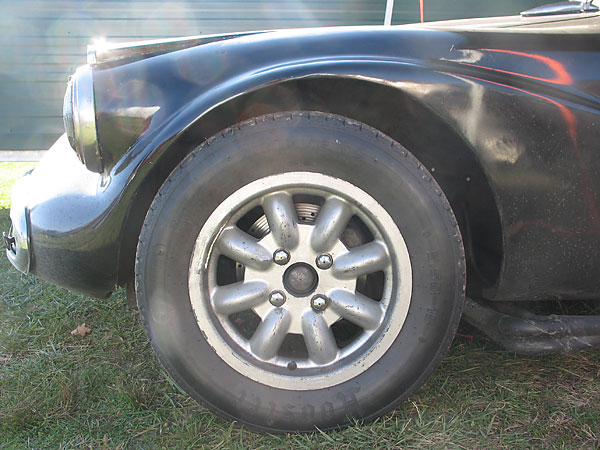
Genuine Minilite magnesium racing wheels.
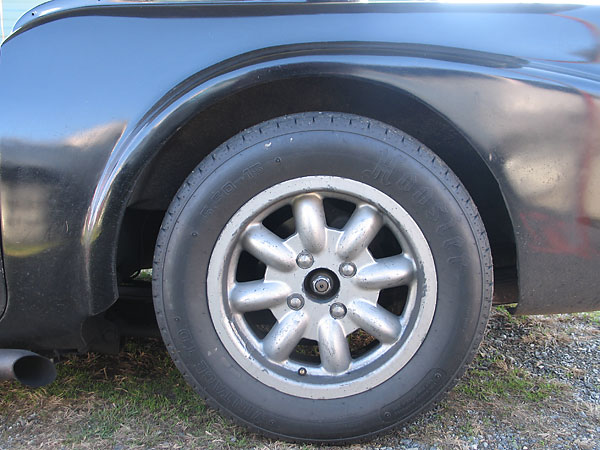
Hoosier Vintage TD 15"x5.50" tires.
All photos shown here are from November 2009 when we viewed the car at VRG's Turkey Bowl
at Summit Point Motorsports Park, West Virginia. Photos by Curtis Jacobson for BritishRaceCar.com,
copyright 2009. All rights reserved.
| If you liked this article, you'll probably also enjoy these: | |||||
 |
Duncan Black 1949 Lester MG |
 |
Mark Rosenberg 1959 Peerless GT |
 |
Larry Ligas 1961 Daimler SP250 |
| You're invited to discuss anything you've seen here on The British Racecar Motorsports Forum! | |||||
Notice: all the articles and almost all the photos on BritishRacecar.com are by Curtis Jacobson.
(Photos that aren't by Curtis are explicitly credited.) Reproduction without prior written permission is prohibited.
Contact us to purchase images or reproduction permission. Higher resolution images are optionally available.


